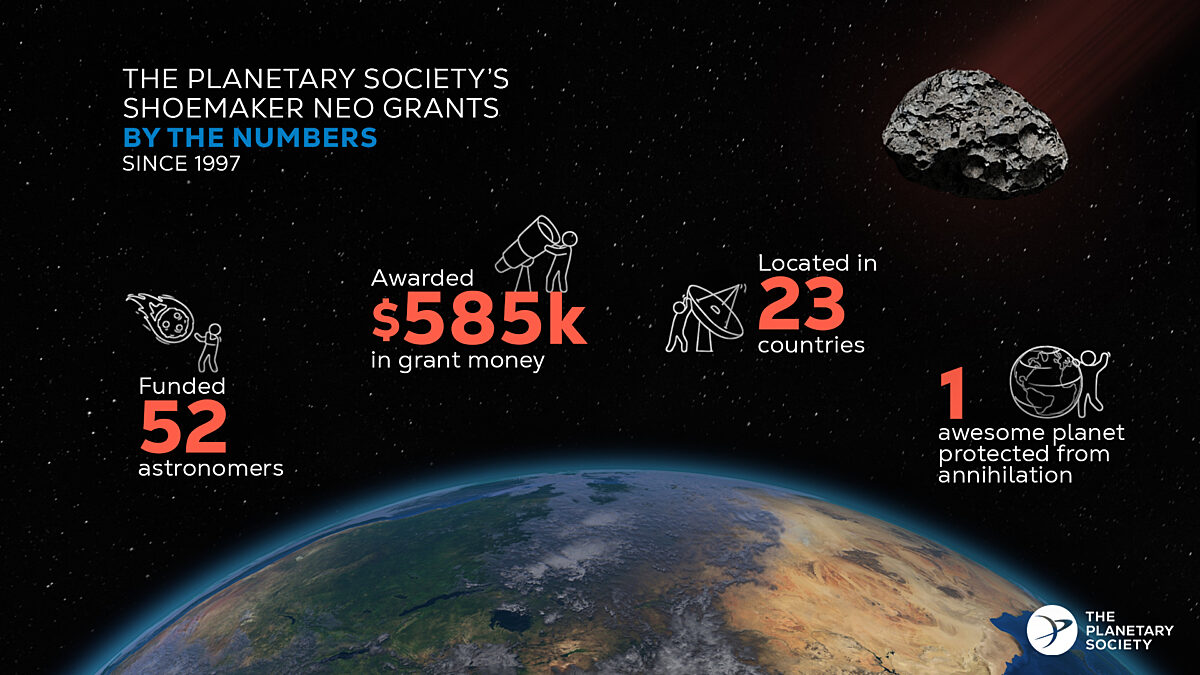The 2023 Shoemaker NEO grant winners have been announced. We anticipate opening another round in 2025. To learn more about the proposal process, see our 2023 Request for Proposals.
The Challenge
Space is vast, but it’s not empty. Hundreds of tons of small grains of space dust bombard Earth daily, flaring brilliantly as meteors when they burn up in our atmosphere. Some become meteorites that survive all the way to the ground. And occasionally, larger objects strike the planet, causing local or even global destruction.
We call space rocks that come close to Earth near-Earth objects, or NEOs. Under the right circumstances a NEO just 20 meters wide could destroy an entire city. In 2013, an object that size exploded near Chelyabinsk, Russia, damaging buildings and sending hundreds to area hospitals. Scientists estimate there are 10 million NEOs larger than 20 meters, and so far we’ve only found a fraction of the small ones.
Fortunately we can stop dangerous asteroids from hitting the Earth. But first we have to find and study them.
NASA and other space agencies are woefully underfunded when it comes to planetary defense. The bulk of new NEO discoveries are made by a network of professional sky surveys, along with current and future space telescopes. When these telescopes find something new, they can’t always stop to take a closer look—after all, they have a lot of sky to cover.
That’s a problem because it can take dozens of observations to determine whether an asteroid will hit Earth. If we want to deflect an asteroid on course to hit Earth, we need as much warning time as possible. We also need more observations to characterize newly discovered NEOs and understand how to deflect one on course to hit Earth.
Hunting for Dangerous Asteroids Bob Stephens from California tracks and characterizes dangerous near-Earth asteroids. The equipment needed for such a task doesn't last forever. With help from our members, asteroid hunters can upgrade their equipment to make sure we find asteroids before they find us.
How We Are Helping
The Planetary Society has funded efforts to find, track, and characterize NEOs practically since our founding. In 1982 we began contributing to a search program led by planetary scientist Eleanor Helin at Palomar Observatory in Southern California.
In 1997 our members and supporters helped us launch the Shoemaker NEO grant program to fund amateur and professional asteroid observers. Named after Gene Shoemaker, who along with his wife Carolyn did so much to raise awareness of the dangers of asteroid impacts, the program has awarded $585,000 to 52 astronomers in 23 countries on 6 continents.
Our Shoemaker grantees have submitted hundreds of thousands of asteroid observations to the International Astronomical Union’s Minor Planet Center, a clearinghouse for the world’s asteroid observations. These observations are used by entities like NASA and the European Space Agency to predict asteroid orbits.

Shoemaker winners also contribute to the field of asteroid science by determining characteristics like spin rates and whether one asteroid is actually a binary pair, crucial to understand when considering deflection. In recent years they have helped NASA confirm a rare double asteroid, observed a fast-spinning asteroid that rotates every 3.5 minutes, and imaged interstellar asteroid ʻOumuamua that visited our solar system in 2017.
Learn about our past winning proposals here and see updates at the bottom of the page:
Where are our asteroid hunters?
What You Can Do
Are you an amateur or professional astronomer who can help us defend Earth from asteroids? See our Request for Proposals (RFP) for more details about what we fund.
Want to get involved in other ways? Become a member or donate to support our work and join the world’s largest independent space organization. You can also help us spread the word to those who might be interested in proposing using the short URL planetary.org/neogrants. You know your audience best; we've got tools to help.
Learn more:
Learn how The Planetary Society works to defend Earth from dangerous asteroids
Will an asteroid hit Earth? Your questions answered
Stay up to date on Planetary Society news and the latest space news by signing up for The Downlink, our weekly newsletter
Ready to take your next steps as a space advocate? Find out how you can take action in your community and government.
Action Center
Whether it's advocating, teaching, inspiring, or learning, you can do something for space, right now. Let's get to work.
Shoemaker NEO Grants in Recent Articles, Newsletters, and Podcasts
Searching the skies to keep us all alive
Astronomers around the world are working to protect the Earth from asteroid impacts, with the help of Planetary Society members and donors.
Announcing the 2023 Shoemaker NEO grant winners
Meet the latest round of winners in The Planetary Society's Shoemaker Near-Earth Object (NEO) grant program, which funds astronomers around the world in their efforts to find, track, and characterize near-Earth asteroids.
Want to be a citizen astronomer and defend Earth from asteroids? Here are some tips.
We asked three Planetary Society Shoemaker NEO grant winners for tips on how to assemble your own planetary defense observatory.


 Explore Worlds
Explore Worlds Find Life
Find Life Defend Earth
Defend Earth






